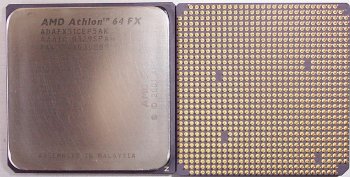FX-51 ?
We've established that 64-bit computing currently offers a number of real-world benefits for purchasers with needs that extend in the workstation or server classes. Add multiprocessor pairings (up to 8) and AMD hopes the Opteron will make serious inroads into those lucrative markets. However, why let a decent chip go to waste, especially when it's rooted in x86 32-bit architecture. Here's where it can all get a little confusing. We'll attempt to unravel the naming system that AMD has in place for these hybrids and then concentrate on the FX-51 in particular.
Therefore, I'd like to take this juncture to explain the different naming structures for AMD's newest hybrid chips. The terms Opteron, Athlon64 and Athlon64 FX have been used interchangeably to refer to a single CPU. As you'll find out in a second, the naming scheme is kind of convoluted and a little misleading at times. The Opteron, launched in April of this year, is the server / workstation chip that can be used in multiprocessor systems (1, 2, 4 or 8-way) through the use of coherent (a link that communicates with another Opteron processor, or two extra links in the case of 8-way systems). Opterons are named either 14x, 24x, or 8xx, with the initial number referring to either single, dual or multiprocessor systems. The x usually denotes the overall speed.
More pertinently for us, the AMD64 FX-51 is an Opteron-based processor that's designed to work in single processor systems. That, then, means it doesn't require any kind of SMP compliance (it doesn't have any coherent HyperTransport links, more on that later). If you've managed to follow that, you'll understand that the Athlon64 FX-51 is, effectively, a re-badged Opteron 148, that is, it's a 1P hybrid 32- and 64-bit CPU, based largely on the K7-series, and sporting a few tasty on-die inclusions that make it faster in 1P work than the existing Barton, especially in memory-intensive applications. And just to confuse you a little further, AMD has another consumer-level CPU that follows in the trend of the Athlon64 FX series, yet it cut costs by omitting a few of performance extras inherent to the A64 FX line. That's the 754-pin Clawhammer, folks.
The discussion thus far has centered on how and why the Opteron CPUs, which are identical to the Athlon64 FX-series, save a few points regarding SMP work and HT buses, and equipped with 64-bit ability, may do well in server markets. Most of our readers, however, may be impressed by its bit duality but just want to know if it'll makes gaming and activities such as SETI faster. We've not yet laid down any hard facts about its potential performance. Time to address that now.
From an enthusiast's / gamer's point of view, the ability to run 64-bit code is neither here nor there. We 1P users are quite content with the present 32-bit CPUs, it seems. Windows XP 64-bit edition is still a few months away and applications will lag a few months after that. Add in time for recompiling present apps to take advantages of 64-bit computing, and you could be looking at a year's time. The Opterons, and by inference the Athlon64 FXs, are quite happy running 32-bit applications in a single CPU system. Let's have a look at the Athlon 64 FX-51 now. That'll raise a few questions.
Click to enlarge
If you've got the patience to count them, you'll find 940 pins on the rear. The present K7-series XP has 'only' 462. More than doubling the pin count has to count for something extremely important. Also note that AMD now uses an integrated heatspreader, much in the vein of Intel with its P4 line. What the above picture cannot illustrate is the weight of these new CPUs. It must weight twice as much as a P4. Manufactured in week 29 of this year and sporting an AAAIC stepping, there's not too much we can infer by the heatspreader's codes. What we can't also gather is the relative size of the Athlon64 FX-51.
Click to enlarge
The FX-51 on the left, a Pentium 4 3.2GHz in the middle and an 'Applebred' Duron on the right. The FX is kind of large when compared to Pentium 4, and much, much heavier.











